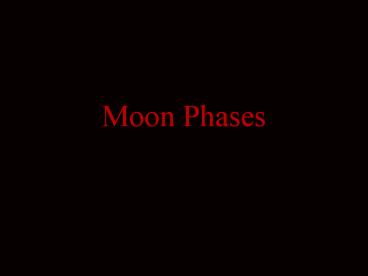Moon Phases PowerPoint PPT Presentation
1 / 61
Title: Moon Phases
1
Moon Phases
2
- If you watch the Moon from night to night you
will notice that it seems wax larger from a new
moon to a full moon then wane smaller from a
full moon back to new. The time from one new moon
to the next is about 29.5 days and is called a
lunar month. - In fact the time it takes for the moon to go from
any phase to the next time it shows the exact
same phase is a lunar month.
3
The Source of Moon phases
- The Moons orbit around the Earth causes the Moon
to have phases. The phases are NOT caused by the
Earths shadow!
4
- Your group will model the Moon as it orbits
around the Earth. Your head will become the Earth
and you will hold a small ball as the Moon. A
light source will be the Sun. You will also be
completing a scriptsheet.
5
What Phase?
- Waxing Crescent
6
Waxing Crescent
7
What Phase?
- First Quarter
8
First Quarter
9
What Phase?
- Waxing Gibbous
10
Waxing Gibbous
11
What Phase?
- Full Moon
12
Full Moon
13
What Phase?
- Waning Gibbous
14
Waning Gibbous
15
What Phase?
- Waning Crescent
16
Waning Crescent
17
Moon Phases
- A few rules will help you understand Moon phases.
18
Crescent Moon
- The Moon will be a crescent when it is closer to
the Sun than you are.
19
Gibbous Moon
- The Moon will be gibbous when it is farther from
the Sun than you are.
20
Waxing Moon
- The Moon will be waxing as it travels away from
the Sun.
21
Waning Moon
- The Moon will be waning as it travels toward the
Sun.
22
- These rules can be used to understand phases seen
with other objects in other places.
23
The Moon is at First Quarter because it is at the
same distance from the Sun as the Earth. Since
the Styrofoam ball is also on the Earth it shows
the same phase.
24
Both the Moon and the water tower are closer to
the Sun than the photographer so both are
crescents. Is the Sun to the left or right of the
picture?
25
(No Transcript)
26
The water tower on the left is even closer to the
sun so it is an even thinner crescent.
27
(No Transcript)
28
(No Transcript)
29
(No Transcript)
30
(No Transcript)
31
Other Phases
- Earth Phases can be seen from the Moon.
Question Which is closer to the Sun, the Earth or
the Moon?
32
Earthrise
Question Which is closer to the Sun, the Earth or
the Moon?
33
Quarter Earth and Moon
34
Gibbous Earth and Crescent Moon
35
(No Transcript)
36
Eclipses
- Eclipses occur when the shadow of one object in
space covers another
37
Lunar Eclipses
38
Lunar Eclipses
- Lunar Eclipses occur when the shadow of the Earth
covers the Moon. They can only occur during the
Full Moon.
39
The Earth is Round!
- The shape of the Earths shadow has long been
used to see both the size and true shape of the
Earth.
40
Lunar Eclipses
Lunar eclipses can be seen from half the Earth.
More people get the chance to see Lunar eclipses
than Solar Eclipses.
41
Solar Eclipses
- Solar Eclipses occur when the shadow of the Moon
covers part of the earth. They can only occur on
the New Moon.
42
Partial Eclipse
Partial eclipses are seen when the Moon covers
only part of the Sun from the viewers location.
43
(No Transcript)
44
Total Eclipse
Total eclipses are seen when the Moon covers all
of the Sun from the viewers location.
45
Transit
An eclipse is similar to a transit. A transit
occurs when one astronomical object passes in
front of another. Here Venus is passing in front
of the Sun.
46
(No Transcript)
47
Tides Tides are caused by gravity. It is not only
the strength of gravity that causes tides but how
gravity grows weaker with distance.
48
The gravitational pull of the Sun or a planet is
greater on nearby objects.
49
The gravitational pull of the Moon pulls ocean
water to the side of the earth facing the Moon.
Water is also left behind on the opposite side
of the Earth.
50
- Both the Sun and the Moon create tides. The
Moons tides are greater than those of the Sun.
These two tidal cause can work together or
opposite to each other.
51
Full Moon Names
52
Farmer's Almanac Blue Moon-The third full moon
in a quarter of a year that has 4 full moons.
Most quarters have only 3 full moons.
53
Calendar Blue Moon-The second full moon in the
same moon. Most months have only 1 full
moon.This term began as an error in a Sky and
telescope magazine article in 1946.
54
Wolf Moon-The first full moon of the year.
55
Snow Moon-The full moon of February.
56
Lenten Moon-The full moon of March.
57
Egg Moon-The full moon before Easter.
58
- Full Harvest Moon
- -The full moon closest to the Autumnal Equinox.
59
- Hunters Moon
- -The first full moon after the Harvest Moon.
60
Faces in the Full Moon
61
Full Moon Shapes

